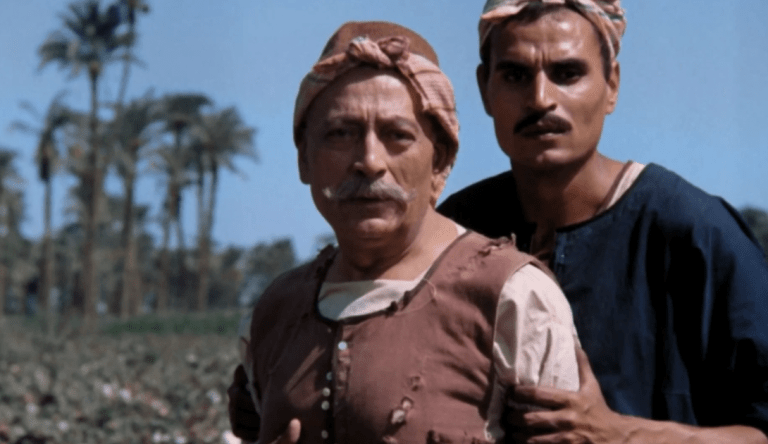From the earliest flickers of cinema, music has been inseparable from the moving image. In the late 19th and early 20th centuries, the Lumière brothers’ screenings were screened alongside performances by live musicians, setting a precedent that would define the silent era, where music was not just accompaniment, but the sole voice of the film.
Then came the revolution of synchronized sound, ignited by The Jazz Singer in 1927, and with it, a new language of storytelling was born—one where music and dialogue could coexist, compete, or complete each other.
Since then, film scores have become one of cinema’s most powerful tools, deepening its emotional impact through reflecting a character’s inner world, shaping the emotional texture of a scene, or channeling what the audience itself cannot yet articulate
Egypt, long hailed as the beating heart of Arab cinema, earned its place on the cinematic map early. In 1896—just a year after the Lumière brothers’ historic screening in the French port city of La Ciotat—Alexandria hosted one of the first public film showings in the world. That moment would mark the beginning of a deep and lasting relationship between Egypt and the silver screen.
From the silent era through the golden age of the 1940s to 1960s and into the present, Egyptian cinema has treated audiences not only to iconic stories and stars, but to unforgettable scores that carved their own emotional path through the narrative. Music has never been a mere accessory in Egyptian film—it has served as a vital emotional compass, articulating longing, tension, joy, and heartbreak when words alone could not.
While modern soundtracks continue to dazzle, the lush, expressive scores of the past—crafted by composers like Fouad El Zahery, Andre Ryder, and Ali Ismail—are too often left uncelebrated. These works helped define the atmosphere of Egyptian romantic comedies, thrillers, and sweeping melodramas, transforming scenes into enduring moments of cinematic memory.
It’s time to return to that golden era, when music didn’t simply accompany the image—it moved with it, deepened it, and sometimes even spoke louder than the dialogue itself.
Al Ard (1969) – Ali Ismail
Colonialism, aristocratic rule, injustice, and an unyielding refusal to give up their land—that’s the story Youssef Chahine tells, and Ali Ismail’s composition translates into music. Together, they create one of the most powerful and raw film scores in Arab cinema, capturing the inner turmoil of villagers determined to protect their land at any cost. Ismail’s use of the nay and rebaba screams with agony, giving voice to those often unheard.
Shey’ Min El Khouf (1969) – Fouad El-Zahery
The score for Shey’ Min El Khouf (A Taste of Fear) stands as one of Fouad El-Zahery’s most masterful contributions to Egyptian cinema—a work where music becomes an instrument of tension, power, and psychological depth. From the very first notes, it immerses the viewer in an atmosphere of suffocating control, reflecting the iron grip Atris holds over the village and the overwhelming fear Fouada experiences in his terrifying presence.
El-Zahery shapes the soundscape with brooding tonalities and weighty, deliberate rhythms, allowing the music to ebb and swell with the film’s dramatic pulse. This creates not just a soundtrack, but an ever-present undercurrent of unease—one that speaks in the spaces between dialogue. In moments where words are absent, the score whispers fear, sharpens silence, and stirs the quiet anger simmering beneath the surface.
Al Zoga Al Thania (1967) – Ali Ismail
The film’s score, composed by Aly Ismail, stands as one of the most memorable soundtracks in the history of Egyptian realist cinema. Deeply rooted in the rural setting of the story, Ismail’s music drew heavily on traditional Egyptian instruments like the nay and rebab, using folk-inspired rhythms to evoke the village atmosphere.
Rather than merely serving as background, the music functions as a narrative voice—expressing the unspoken emotions of oppression, submission, and quiet resistance. This is especially evident through the character of Fatma (played by Soad Hosny), who embodies defiance in the face of authoritarianism and totalitarianism by refusing to marry the mayor intent on forcibly divorcing her from her husband. Amid this tense and thrilling atmosphere, the score subtly traces her emotional journey—from fear to defiance.
Rod Qalby (1957) – Fouad El-Zahery
Composed by Fouad El-Zahery, the soundtrack of Rod Qalby stands as one of the most emotionally rich and iconic scores in Egyptian cinema. Set against the backdrop of class struggle and the 1952 revolution, the film follows a love story interrupted by social divisions, reflecting the social, economic, and political dynamics of the time. The music weaves together themes of romantic longing, heartbreak, and national awakening.
El-Zahery crafted a sweeping orchestral score layered with distinctly Eastern melodies, capturing the duality of tenderness and rebellion. His music didn’t just accompany the narrative—it elevated it, setting the emotional tone for moments of despair, sacrifice, and eventual triumph.
Shabab Emraa (1956) – Fouad El Zaheri
Fouad El-Zahery’s score for Shabab Emraa stands as a deeply atmospheric and gripping musical journey, amplifying the film’s raw portrayal of desperation, desire repression, and moral conflict.
Against a backdrop of societal breakdown and personal struggle, the music captures the restless tension and emotional weight carried by the characters. El-Zahery blends haunting melodies with unsettling rhythms, creating a soundscape that not only reflects the film’s dark narrative but also gives voice to the inner battles fought silently within, against oneself, what he stands for, and the society overall.
Al Qahira 30 (1966), Fouad Al Zahery’s Composition
The film roared with revolution—against corruption, against poverty, against deprivation—and its score rose to match, a piercing cry of pain in the face of injustice. Adapted from Naguib Mahfouz’s novel, it unfolded as an allegorical portrait of Cairo under the monarchy, its rebellious spirit carried on the bow strokes of urgent violins in a relentless, rhythmic anthem.
The music mirrored the city’s moral decay, tracing the desperate compromises of a man willing to trade his own wife for a handful of hollow gains. As the story’s horrific events unraveled, Al-Zahery’s score wove through them with unflinching force—an accompaniment that could not have been more perfectly realized.
These soundtracks weren’t just background—they carried emotion, deepened narrative, and remain essential to Egyptian cinema’s legacy.
WE SAID THIS: Don’t Miss…Celebrating Musician Ayman Bahgat Kamar Through His Diverse Work In The Entertainment Industry



